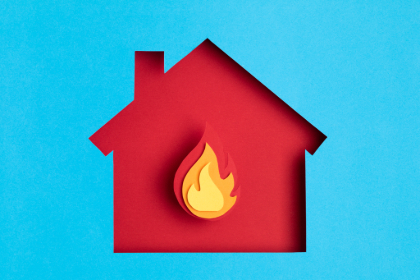Disaster Cleanup & Restoration
24/7/365 Emergency Service
Palm Desert Office: (760) 320-2128
Servicing Riverside County, CA

If you’ve experienced a fire or want to be ready just in case, don’t wait until smoke is in the air. This post by Daniel's DKI in Riverside County, CA will share what happens in a house fire, so you can prepare properly.

When people think of house fires, the first thing that comes to mind is flames—big, dangerous, and destructive. And while that’s definitely the headline, the full story goes well beyond what you see on the evening news. Fire is only the beginning. What’s left in its wake is a complicated mix of damage that can impact your home long after the smoke clears.
Whether you’ve experienced one yourself or just want to better understand the risks, here’s what happens in a house fire, besides the obvious.
What happens in a house fire can be devastating. Call Daniel's DKI in Riverside County, CA at (760) 320-2128 if you need professional assistance getting your life back together.
What Happens in a House Fire
Smoke Goes Everywhere
Flames may be contained to a single room, but smoke has no boundaries. It drifts through hallways, slips into vents, and settles into walls, insulation, and fabrics. Even in rooms untouched by fire, you’ll often find soot on ceilings and a persistent smoky smell in everything from clothing to drywall.
What’s worse? Smoke residue is corrosive. Left unaddressed, it can permanently stain walls, rust metal appliances, and ruin electronics. That’s why smoke damage cleanup is a huge part of post-fire restoration—and why it needs to be handled fast and professionally.
Water Damage Follows Fire
Here’s something most people don’t expect: your house may be soaked. Firefighters use powerful water hoses to stop the flames—and in the process, they saturate walls, floors, and furniture. In multi-story homes, water often seeps from upper floors to lower ones, leaving ceilings bowed and insulation drenched.
If not dried quickly, this moisture can lead to mold growth, structural instability, and electrical hazards. So in many cases, water damage mitigation runs parallel to fire damage cleanup.
Your Home Becomes a Chemistry Lab
When household items burn—like plastics, foams, and synthetic fabrics—they release toxic chemicals into the air. That includes formaldehyde, benzene, and a whole list of substances you don’t want in your lungs.
Soot and ash can contain these chemicals long after the fire is out. That’s why post-fire environments can be hazardous, and why protective gear is essential for anyone doing cleanup. Restoration crews often use specialized air scrubbers and HEPA filtration systems to clear out these contaminants safely.
Call Daniel's DKI in Riverside County, CA at (760) 320-2128 for a free estimate on professional restoration services.
HVAC Systems Turn Into Smoke Delivery Systems
If your HVAC system was running during the fire (or even if it wasn’t), there’s a good chance smoke and soot made their way into the ductwork. When that system is turned back on, it spreads odors and particles throughout the entire home, effectively re-contaminating clean areas.
As a result, duct cleaning is often a key part of a thorough restoration plan. It’s not just about comfort; it’s about health and safety too.
Fire Doesn’t Discriminate (But It Does Travel)
Fires often jump from one area of the house to another in ways that are hard to predict. That means some structural damage may be hidden behind walls or under floors. Wood framing might be scorched or weakened, even if it looks okay on the surface.
Restoration experts often need to peel back layers—literally—to assess the true extent of the damage. It's not uncommon to find that damage extends far beyond what’s visible to the naked eye.
Insurance Gets Complicated
Even with good coverage, navigating a fire damage insurance claim can be stressful. From documenting damage to working with adjusters, the paperwork alone can feel like a full-time job.
One of the advantages of hiring a professional restoration company is that they often work directly with your insurance provider. They know what documentation is required and how to ensure nothing gets overlooked, especially the hidden damage that could come back to bite you later.
Recovery Takes Time, But It's Possible
House fires are traumatic. They disrupt routines, destroy memories, and often force families to relocate temporarily. But recovery is possible. With the right team and the right plan, homes can be rebuilt, and in many cases, improved for safety and comfort moving forward.




